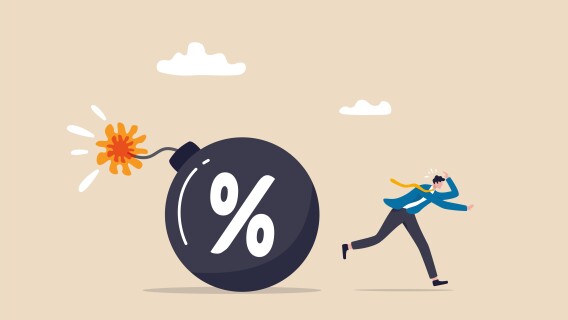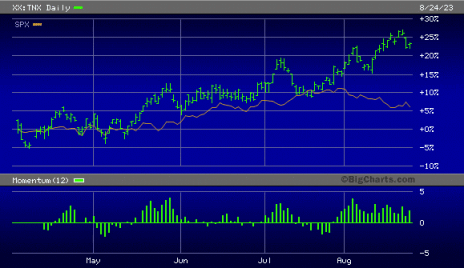Everyone is suddenly talking about the Treasury yields, and that’s usually not a good thing for stocks.
Indeed, a growing number of news headlines are drawing attention to mounting concerns over rising government bond yields, or more specifically, what it means for the economy. One such article from Market Insider was widely distributed across financial newswires recently, and it featured the opinion of the well-known economist Ed Yardeni.
The headline proclaimed, “Bond markets are flashing warning signs even as recession forecasts get dialed back,” and the gist of it is that as the 2-year bond yield hovers around 5%, while the 10-year yield quickly catches up to it, there’s a growing possibility that “de-inversion” of the yield curve will undermine equity market performance as investors pursue higher-yielding bonds.
[text_ad]
Market Insider further observed:
“Higher long-term rates is bad news for banks, which are already suffering from higher interest rates and shaky bases of deposits. Higher rates would also likely be a complete disaster for the commercial real estate industry, a sector that has around $1.5 trillion worth of debt that will soon need to be refinanced.”
Yardeni was quoted as saying, “The number one risk now is the de-inversion that occurs in the yield curve occurs in an unusual fashion” adding that it “could create a whole new set of problems to the economy.”
The article concluded that the Fed is likely to dial back interest rates next year “thanks to cooling inflation.”
Not everyone agrees with this sentiment, however. It’s true that the Fed ending its rate-hiking campaign next year has become something of a consensus view among market participants, as evidenced by the CME FedWatch Tool. In fact, it shows lower target rate probabilities beginning next spring and continuing into the end of 2024.
Also, the broad expectation on Wall Street is that the Fed will be done with its rate hike cycle possibly this year. Yet earlier this month, Fed officials indicated that further rate hikes may be needed before inflation is contained.
More pertinently, rising Treasury yields are a leading indicator suggesting that inflation remains a stubborn problem that hasn’t yet been extinguished—and that could further upset the consensus view that the Fed is finished tightening. Already, the upward trend in U.S. government bond yields has had a measurable impact on equity prices (and has arguably been the main catalyst behind recent equity market turbulence).
On that score, consider that in the last 30 years, a sustained multi-month rise in the 10-Year Treasury Note Yield Index (TNX) has put downward pressure on stock prices as measured by the S&P 500 Index (SPX)—to some degree or other—in 93% of those years.
In only two of those 30 years did TNX and SPX rally together for an extended period, namely in 1999 and 2013. In both of those exceptional cases, however, 10-year yields were coming off major lows while the economy was bouncing back from what could be described as semi-deflationary economic conditions.
This time around, by contrast, inflationary conditions are far more prevalent—and that means equities are less equipped to deal with additional market rate increases. Note in the chart shown here that the latest growth spurt in TNX has had a wilting effect on the S&P. It’s worth noting the 10-year U.S. Treasury yield is up 40% in the past year and sits around 4.2% as of late August—its highest level since 2007.
Further, if we acknowledge that rising yields are a major catalyst for the stock market’s recent weakness, we should also be prepared for the possibility that unless 10-year yields drop sharply, the stock market could remain under pressure in September, with weakness accelerating should bond yields continue to rally on a sustained basis.
A final insight worth mentioning is that Steven Blitz, chief U.S. economist at TS Lombard, doesn’t believe the Fed will begin easing until the unemployment rate hits 4%, “and not before.” In a recent client note, he wrote that the risk of an “upward bias to inflation is not a probability to be ignored,” adding that an eventual rise to 6% in the 10-year yield and a 6.5% Fed Funds rate “wouldn’t be a surprise” assuming there’s no recession by autumn.
All things considered, investors should probably hold a little more cash than would normally be considered prudent in a bull market until the threat of rising rates has abated.
[author_ad]



